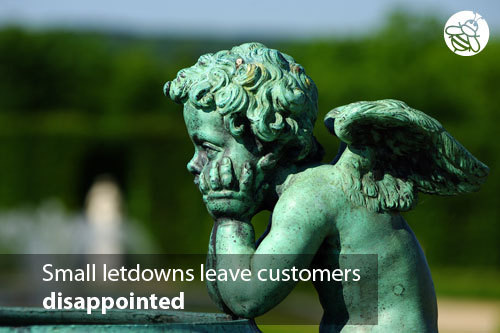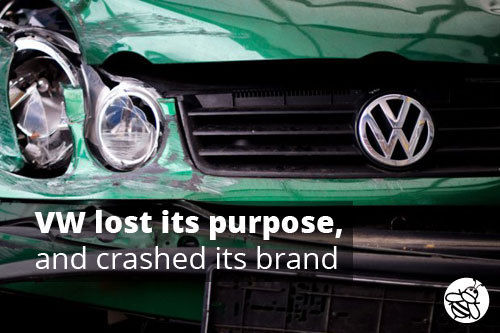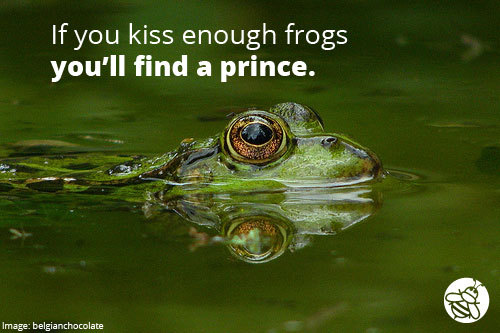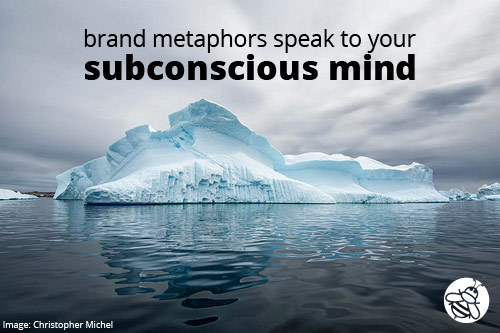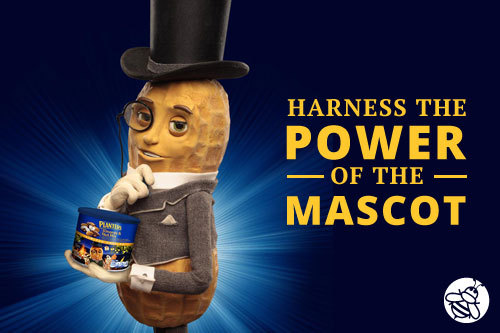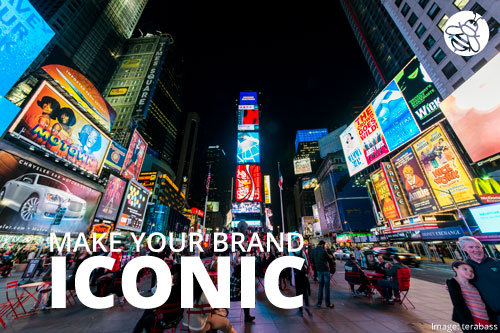Jeremy Miller's Blog, page 34
October 1, 2015
Small Letdowns Tarnish a Brand
Major brand screw ups are anomalies. Stories like Volkswagen’s willful deception of emissions standards is shocking, but unusual. Companies don’t get caught deceiving millions of customers very often, and when they do it’s a major news story.
The real attack on brands is far more mundane. Brands are eroded internally by small breakdowns in service. These breakdowns are usually minor in nature. They are situations when a company doesn’t meet a customer’s expectations and lets them down.
These problems aren’t big enough to cause customers to revolt or leave, and are definitely not big enough to make the news. But these are the problems that customers remember.
Every time a company lets its customers down it is eroding trust in the brand. It’s like making a withdrawal from the trust bank. Trust is built up with customers over time through positive experiences, but small letdowns draw down on that goodwill.
Small letdowns are insidious because they often go unnoticed by the company. The issues are relatively minor, but they can add up. If a brand lets its customers down one too many times it may be forced to employ acts of customer service heroism just to maintain an average brand.
A Case Study in a Small Letdown
On Friday, September 25th, Telus failed to deliver pre-ordered iPhone 6s and 6s Pluses to its customers. It was launch day for the new iPhones, and customers were anxiously awaiting their shiny new objects.
I was one of those customers waiting for my phone to arrive, but it didn’t come. (In fact, it didn’t arrive until Wednesday — five days after the launch date.)
I wasn’t alone. A quick search on Twitter revealed several people were very disappointed to not receive their pre-ordered phones.

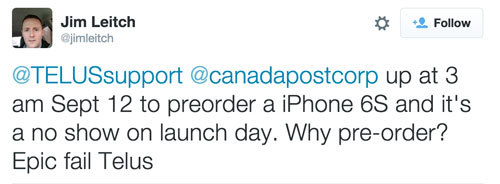
In the realm of customer service issues missing a launch date delivery is a pretty inconsequential problem. Telus does not guarantee delivery dates, and their service team was highly responsive to the complainants.
But this small misstep made a significant withdrawal from Telus’s trust bank.
Customers Have Expectations
Every company makes mistakes. It’s unavoidable. And when a problem arises you deal with it and try to come to a reasonable resolution with the customer.
Small letdowns, on the other hand, are generally avoidable mistakes. These are customer service issues that shouldn’t happen, because they’re the basics of running a good business.
For example, when you go to a restaurant you expect to be greeted and seated promptly. When you buy a new car you expect it to be washed, gassed, and have that “new car smell” when you go to pick it up at the dealership. When you pre-order an iPhone you expect to receive it first, because you made a commitment before everyone else.
These aren’t technically customer service issues; they are customer expectations.
Your customers expect a certain level of service, and it’s your company’s job to fulfill that promise. When you fail to meet your customers’ expectations you let them down, and that erodes trust in your brand.
In fact, a small letdown can erode more trust than a substantive customer issue, because the small letdown flies under the radar and goes unsolved.
Making Withdrawals from the Trust Bank
Small letdowns erode a brand one withdrawal at a time. Every time a company doesn’t meet its customers’ expectations — no matter how small or inconsequential — it is making a withdrawal from the trust bank.
I was curious to hear how customers felt about not having their iPhone’s on launch date and asked them, “How did the no show make you feel about Telus?” The responses ranged from diplomatic to irate.
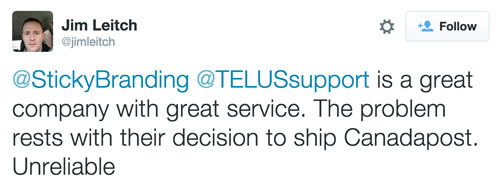
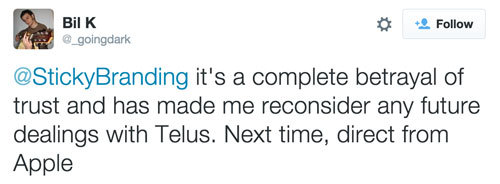
What should have been a win for Telus turned into a letdown.
World Class Customer Service Isn’t Enough
The customer service team is an organization’s frontline heroes, but often they are picking up the pieces from failures created in operations, logistics, and sales.
Telus has an award-winning customer service team, and it was a delight to watch them respond to complaints on Twitter. They were fast, courteous, and personal. They apologized for the inconvenience, and tried to insert humor into the conversation.
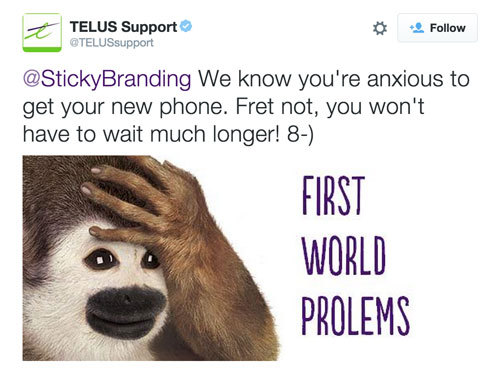
It was a cute response, and on brand for Telus (except for misspelling “problems”). This is why their customer service team gets accolades.
The customer service team was responding to an issue that didn’t have to happen. Jane Torrance tweeted, “I got animals instead of a phone.”
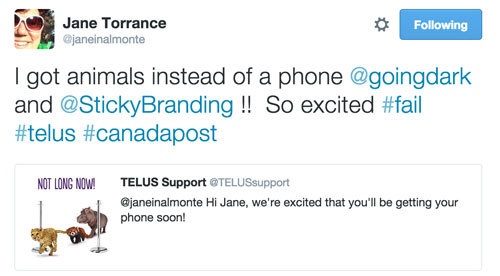
The customer service team helped stop a run on the trust bank, and they mitigated some of the damage. But not all of it.
Acts of Heroism Make Great Stories
Acts of customer service heroism make for great stories, but brand trust is built in the day to day experiences.
For example, Morton’s Steakhouse delivered Peter Shankman a steak to the airport based on a tweet.
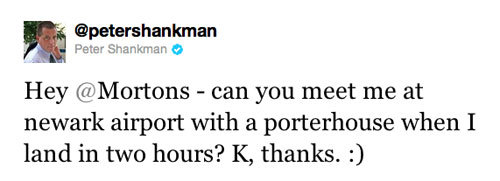
When Peter arrived at Newark Airport Morton’s was there to greet him with a steak. He described the experience as “The Greatest Customer Service Story Ever Told, Starring Morton’s Steakhouse.” It was a heroic act of customer service, and Peter shared the story broadly in his blog, speaking, and other venues.
But that’s not what makes Morton’s Steakhouse great. It’s their operations and ability to deliver a consistent customer experience that builds the brand. The company is committed to being brilliant at the basics — from how they serve their guests to how each steak is prepared.
It’s easy to celebrate the heroic stories, but you can’t be a hero without being brilliant at the basics first. The basics are where you make the most deposits in the trust bank, and the acts of customer service heroism just push your brand through the stratosphere.
Contrast that to companies who are not brilliant at the basics. They have to use acts of customer service heroism to compensate for their small letdowns. When a customer service team is always working with a low or negative balance they have to go well above and beyond the call of duty to bring customers back to a reasonable level of engagement.
Be Brilliant at the Basics
Small letdowns are breakdowns in the basics.
It may be interesting and fun to talk about the heroic acts of customer service, but the heroics are pointless if you’re not brilliant at the basics.
The basics are the essential components of a business. They are the simple day to day activities that build trust and deliver value, and this is what customers expect.
Sticky Brands are brilliant at the basics. Their brands stand out, because they rarely let their customers down.
September 24, 2015
Volkswagen Lost Its Purpose to be the Biggest Automaker
There is a tension between purpose and growth. When a brand sets its sights on growth alone it can lose its way and crash its brand.
In 2007 Volkswagen set a lofty goal for itself: to become the world’s largest automaker by 2018. The company achieved its goal three years ahead of plan.
The Globe and Mail reported in July of this year, “Volkswagen overtook Toyota as the world’s largest carmaker by sales in the first half year, achieving its long-held ambition three years ahead of target.”
 Now, a little over sixty days later, the wheels are falling off the VW bus. The company’s stock is down nearly twenty percent and the company is reeling from revelations that it willfully circumvented the clean air regulations.
Now, a little over sixty days later, the wheels are falling off the VW bus. The company’s stock is down nearly twenty percent and the company is reeling from revelations that it willfully circumvented the clean air regulations.
To improve its emissions, likely with the objective to increase vehicle sales, Volkswagen equipped its diesel cars with a “defeat device.” The device detects when a vehicle is undergoing an emissions test, and it turns on all of the car’s emissions control systems. After the test is over the device switches off the controls. This improves performance, but also allows the car to pollute up to forty times over the allowable limits.
This is shocking. Consumers buying VW and Audi TDI vehicles believed they were buying a more efficient and more environmentally friendly vehicle, but the reality is much different.
Volkswagen’s pursuit of growth caused it to ignore its values and crash its brand.
Growth Is Not Purpose
What does it mean to be the world’s largest automaker?
Being the biggest has its benefits. Increased economies of scale can enhance the company’s buying power. More cars on the road can generate higher brand awareness.
Probably the biggest reason to become the largest is to claim you’re the largest. Being the largest automaker has a king of the castle kind of ring to it. It’s a psychological achievement for the executive team.
But how does that translate as a benefit for the consumer?
Roger Martin writes in Playing To Win, “Starbucks, Nike, and McDonald’s, each massively successful in its own way, frame their ambitions around their customers. And note the tenor of those aspirations: Nike wants to serve every athlete (not just some of them); McDonald’s wants to be its customers’ first place to eat (not just a convenient choice for families to go). Each company doesn’t want to serve customers; it wants to win with them.”
Volkswagen does not have the same tenor of purpose. Becoming the world’s largest automaker has nothing to do with the customer, and everything to do with the egos of VW’s leadership team.
VW Built a Brand With Purpose
What I find disturbing about the latest news surrounding VW is they tarnished an iconic brand. And they tarnished it for short term gains.
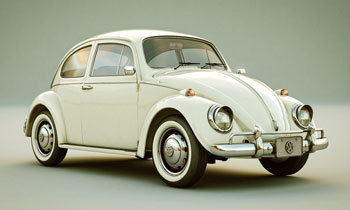 Volkswagen was founded with a purpose; it was the “People’s Car.”
Volkswagen was founded with a purpose; it was the “People’s Car.”
In the early 1930s, most Germans could not afford a car. The German auto industry was largely composed of luxury vehicles, and only one in fifty Germans owned a car. The population used motorcycles instead.
In 1933 the German government got involved. They wanted German citizens to have the same access to a car as Americans. The People’s Car project set out to create a small, cheap rear engined car for the average person.
The vehicle, which became the Volkswagen Bug, had to adhere to two criteria:
Capable of transporting two adults and three children at 100 kilometres per hour.
Available to citizens for about the price of a small motorcycle.
These are incredibly clear and compelling guidelines for a brand. They stated the why, the what, and the who:
Why: Make a car that’s accessible for anyone — the People’s Car.
What: A small, cheap rear engined car that two adults and three children could ride in at 100 kilometres per hour.
Who: Families and average people.
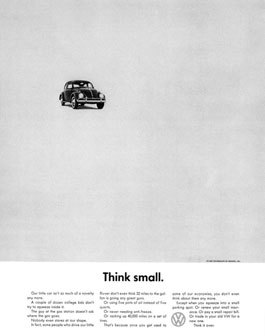 A purpose doesn’t get much clearer than that.
A purpose doesn’t get much clearer than that.
Following World War II, Volkswagen continued to evolve and adapt its brand. The Think Small advertising campaign is one of the most brilliant print campaigns of all time. The VW Bug built on its roots of the “People’s Car,” but it was positioned in the United States as a symbol for people who wanted a car that was different.
The ad copy read:
Think Small
Our little car isn’t so much of a novelty anymore.
A couple of dozen college kids don’t try to squeeze inside it.
The guy at the gas station doesn’t ask where the gas goes.
Nobody even stares at our shape.
In fact, some people who drive our little flivver don’t even think 32 miles to the gallon is going any great guns.
Or using five pints of oil instead of five quarts.
Or never needing anti-freeze.
Or rocking up 40,000 miles on a set of tires.
That’s because once you get used to some of our economies, you don’t even think about them any more.
Except when you squeeze into a small parking spot. Or pay a small repair bill. Or trade in your old VW for a new one.
Think it over.
VW had a purpose, and this is why people have such a fond perception of the brand.
Ignore Your Values, Crash Your Brand
Will VW survive this crisis? Sure. Will consumers forgive them? Yes, eventually. Has VW tarnished its brand? You bet.
Embedding a defeat device in its cars is plain and simply fraud.
VW’s brand is about great engineering. It was supposedly a pioneer in clean, sporty, and fuel-efficient diesel vehicles.
The pursuit for growth clouded the leadership team’s judgement, and caused them to deviate away from the company’s core values.
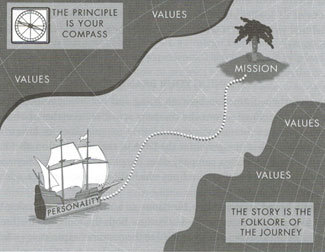 In the book Brand Driven, the authors present an excellent metaphor on the importance of values. They write, “Imagine, you’re taking a boat trip to an island. The island is your destination, that is, your mission. How do you get there? First, you have to stay within the banks of your values: you probably won’t arrive in one piece if you run aground — in fact, you may never arrive at all.”
In the book Brand Driven, the authors present an excellent metaphor on the importance of values. They write, “Imagine, you’re taking a boat trip to an island. The island is your destination, that is, your mission. How do you get there? First, you have to stay within the banks of your values: you probably won’t arrive in one piece if you run aground — in fact, you may never arrive at all.”
Your ship will continue to sail if you change your brand, change your purpose, change your positioning, and change your service model. You risk crashing into the shores if you tamper with your values, and these crashes can severely damage your company.
VW has run ashore and the damage is already substantial:
Volkswagen stock is in free fall. The stock hit a four year low two days after the news was revealed.
Martin Winterkorn, CEO of Volkswagen AG since 2007, has resigned.
Volkswagen will recall 482,000 diesel passenger cars from the road in the United States alone. VW says 11 million vehicles are affected globally.
Environmental regulatory bodies are investigating the issue and preparing steep fines and penalties.
VW could face fines of $18 billion in the United States, according to the EPA.
Class action lawsuits will plague the company for years to come.
The most devastating loss of all is consumer trust. VW can recover from the financial penalties, but the costs of rebuilding trust and rejuvenating the brand could be incalculable.
Breaking its values has put VW in a precarious position, which begs the question. Was being number one worth it?
Sticky Brands Are Built With Purpose
The crisis at Volkswagen is an important reminder: ambition does not trump purpose.
Sticky Brands are built for their customers. They have a deeper purpose. It’s not simply about money or profit or market share. It’s about making a difference for your customers.
Volkswagen had that purpose. It was founded as the People’s Car — a purpose that guided the company and fuelled its growth. And with well executed marketing, VW became an iconic brand.
VW made a significant mistake. It used its corporate ambitions as a purpose. Market share and revenue targets are not brand building tools. They are the results of growing a remarkable brand.
Your company’s purpose shapes its brand. Hold onto that. Use your company’s purpose to guide you to create products and services that positively impact your customers.
September 17, 2015
Personal Branding Strategy: How to Get Really Famous
Personal Branding Event: I am speaking in New York City on September 30th on personal branding. Shocase is hosting the event for Advertising Week. We’re delving into what it takes to build your brand online. I hope you can join us.
Everyone has a personal brand. Like a business, your brand is your reputation. It’s how people perceive you and what they say about you. You have a brand by simply being a professional and showing up for work every day.
The topic of “personal branding” is not for people who just want to have a positive reputation. Personal branding is for people who want to get famous.
When you look at your industry and you look at the people you admire, chances are their reputation is greater than their network. They reach and influence a lot of people. And that’s what personal branding is all about.
Personal branding is a deliberate process to stand out, engage an audience, and deliver to them a great deal of value. And you have the power to do this. Anyone can grow their personal brand, be an influential member of their community, and even develop a wee bit of fame.
The strategy for personal branding is practical and accessible: consistently create and share content that a defined audience values. That’s it in a nutshell.
So let’s unpack this idea and examine a personal branding strategy that you can adapt and apply to your business right away.
We All Start Somewhere
We all have to start somewhere.
Personal branding is very similar to a fitness regime. Nobody walks into a gym for the first time and squats five hundred pounds. Developing strength is a process. It takes time, effort, and deliberate steps to become very strong. Personal branding is the same.

You can see this in my stats (Graph: Sticky Branding Social Media). In 2010 I hit the reset button on my content marketing and social media activities. I was transitioning from my family’s business to launch Sticky Branding.
I was already well versed in digital marketing, but the audience for my content was tied to the business. To grow my personal brand under Sticky Branding meant starting from scratch.
On June 25, 2010 my social media reach was 806 people. I had 638 LinkedIn connections, 158 Twitter followers, 5 Facebook Page Likes, and 5 members of the Sticky Branding LinkedIn Group.
Fast forward to today, a little over five years later, and my reach across these four platforms exceeds 58,500 people. The audience grows on average by 255 people per week.
It’s easy to see the size of my LinkedIn Group and say “I want that.” But like everyone else, I started from zero. You don’t have to feel overwhelmed when you start personal branding. Start with what you have and grow it from there.
Define Your Audience
As with corporate branding, a personal brand cannot be all things to all people. A strong personal brand is clearly linked to a discernible community or audience.
Mara Einstein writes in Brands of Faith, “To be effective, authors must be associated with a single topic.” She argues that a personal brand is linked to a topic. For example, an author with a brand in personal relationships will struggle to speak with authority on another topic like corporate finance, even if she knows a lot about the topic.
The reason for this is perception. As a personal brand grows it becomes intrinsically linked with the audience and their expectations of you.
Your audience is the focal point of your personal brand, and this is a very important distinction. Without a clearly defined audience you risk preaching aimlessly to the masses, or worse yet talking to yourself.
You can define your audience in two ways:
Category: Your expertise or topic of interest.
Demographics: The profile of people you are trying to engage.
Category
One of the fastest and easiest ways to define your audience — at least in the very beginning — is to select your “Amazon category.” Where do people go on Amazon to find your topic or area of expertise?
For example, when I wrote Sticky Branding I positioned the book by its Amazon category: branding. A book is a product, and I was writing for people that have “branding on the brain.”
Amazon is a great resource for selecting your category, because they are dividing books into logical segments that generate traffic. This gives you an indication of where you can position your brand, as well as who are the influencers that are active in that community.
Demographics
If your personal brand doesn’t fit into a nice box, like “branding,” you may gravitate towards defining the attributes of your audience.
Tim Ferriss — best known for his book the 4-Hour Workweek — has a well defined audience. He said in a recent presentation, “My first market for the 4-Hour Workweek was 25 to 40 year old tech-savvy males in San Francisco and New York.”
The tight demographic focus helps Tim not only create content that will resonate with his target audience. It helps him market and grow his brand. Rather than trying to engage everyone, he focuses his marketing and public relations on places he knows his target audience will be.
Content Marketing Routine
Defining your audience sets the tone and direction for your content. This is where the rubber hits the road.
Your personal brand is tied to how well you can reach and engage your audience. And this is all about content and content marketing. The more content you create, the more opportunities you will have to engage your audience.
The challenge is personal branding is a marathon, not a sprint. To be effective you have to show up month after month, if not day after day. This is a journey that doesn’t have a conclusion.
With that in mind, look at your content marketing strategy as a routine. You are going to set a pace and stick to it:
Minimum: 1 post per month
Optimal: 1 post per week
Powerhouse: 3+ posts per week
The minimum pace is one piece of content per month, whereas a powerhouse will publish several times a week (and some even post multiple times per day).
The key is to choose the pace that you can sustain.
Pick Your Medium
If you’re a great writer, write. If you’re a great speaker, speak. If you’re a great interviewer, interview.
The most common form of content marketing is writing. People blog, write white papers, or participate in discussions on social media. The web is built for the written word. But writing is only one option.
Choose the medium that fits your talents and delivers the most value for your audience. You can podcast, curate images in Pinterest, create infographics, network on LinkedIn, produce videos for YouTube or Vine. The choices are really endless.
Pick the content platform that both interests you and plays to your strengths. I write and speak, because that’s what I’m good at. What’s your medium of choice?
Email First
Email is your most important content distribution tool. If you were to choose only one tool to engage your audience, choose email.
According to a McKinsey study, email conversion rates are forty times higher than Facebook and Twitter. The report goes on to say, “91 percent of all US consumers still use e-mail daily, and the rate at which e-mails prompt purchases is not only estimated to be at least three times that of social media, but the average order value is also 17 percent higher.” That’s astonishing.
Email is old and boring, but it works. Begin developing your email lists early. Encourage visitors to your website to subscribe to your content via email. Ask people if you can add them to your lists.
One email subscriber is worth more than 1,000 Twitter followers.
Automate the Process
The work described above may seem overly taxing, but a lot of it can be automated.
My platform is almost entirely automated. The bulk of the work goes into creating the content, but the tools do the heavy lifting to share the content.
The tools I recommend (and use) for content marketing:
WordPress Website: Use a custom WordPress blog for your content. Facebook and Instagram make it really easy to build your brand online, but you don’t own those platforms. Treat social media as an outpost to your content, and publish to your website first.
Co.Schedule: Co.Schedule is a brilliant social media scheduling tool that integrates fully with WordPress. When you create a post you can schedule all of your social media updates. This helps keep your content top of mind.
MailChimp: The MailChimp RSS-to-Email service allows you to distribute content from your blog directly to your email subscribers. It grabs the content at a predefined time and packages it in a custom designed email template. This is the most important tool in my content distribution arsenal.
Buffer: Buffer is great for all of your other social media sharing and scheduling. You can build schedules for each social media platform, and fill them up with content and updates so that you’re always active online.
There are even more tools you can use, but this is a good starting point. Use the tools to automate your process and make your life easier. The idea is to make personal branding sustainable.
Get OCD on a Topic
We’ve talked a lot about creating and sharing content, but this inevitably leads to a question. “What do I write about?”
Lack of clarity on what you’re creating can be a real stumbling block to building your personal brand.
If you’re struggling with what to write about get OCD — obsessive-compulsive disorder — on a topic. Choose a skill or a practice that you want to develop, and take your readers on the journey. Share with them what you’re learning, your results, and the tips and tricks you are acquiring in real time.
This is what Tim Ferriss does. He calls himself the “human guinea pig.” He goes out of his way to learn new skills, and then deconstructs them so that others can learn from his experience.
I love this approach. It makes content marketing and personal branding so much easier, because you’re speaking from an authentic position. You may not know everything about the topic, and that’s ok. Your job is to share your experiences, the lessons that resonate with you, and how others can learn from you.
The process is simple. Commit to a deep dive on a topic for at least six months. Read everything you can find on the topic. Talk to as many experts as you can. And apply everything you’re learning to master the skills. As you go through this process create content so that others can learn from you.
For example, you may want to master search engine optimization, and that’s what you’re going to delve into for the next six months. SEO will be your world. You’ll then write about it, speak about it, and share your lessons with your audience.
Your learning experiences will shape your content by providing you a meaningful topic. It will also make your content more interesting, because your passion and interests will be hard to contain.
The only caveat is you’ve got to get OCD on a topic that resonates with your audience.
Connect to New Audiences
Personal brands don’t grow themselves. You’ve got to take the initiative and responsibility to grow your audience.
Guest posting is an integral part of growing your personal brand online. It’s the most effective way to reach new audiences and build brand awareness.
A good rule of thumb is a one-to-one content creation plan. For every piece of content that you create for your own website and social media channels create one more for someone else.
For example, I generate four to six guest posts per month. Some posts are for regular columns, and others are one offs. These articles deliver a ton of value to my personal brand. They provide credibility, because a site with authority is endorsing my brand. They provide inbound links for my website, which drives more visitors to my website. And most importantly, these articles reach new people that have never heard of me before.
Put content outreach as a cornerstone of your personal branding strategy. This is where you’ll really get famous.
With your content outreach strive to develop columns — places you can share content on a regular basis. Your brand grows with repeat impressions. It’s a goldmine if you can land a column in a major publication like the Huffington Post, Forbes, or HBR.
Secondarily, continually work to reach new audiences. Keep seeking new places where you can share your content and grow brand awareness.
Find Accelerators
Personal branding is not a solo mission, it’s synergistic. There are plenty of people who have been there and done that, and many of them are more than willing to help you out.
When I launched Sticky Branding (the book) I hired Gini Dietrich and her team to help me market it. I made one simple ask to Gini, “Let me ride in your wake.”
Gini is ahead of me in the personal branding journey. She’s written two bestselling books. Her blog, Spin Sucks, is one of the most influential PR blogs in the world. And she’s a sought after professional speaker. She was doing everything I was (and am) aspiring to.
Gini has been a fabulous mentor, but we’ve also helped each other grow our brands. We’ve collaborated online, and pointed our spotlights at each other. This helps us raise each other’s profiles while linking our audiences. This is very beneficial for both of us.
Collaboration is key part of personal branding. This is the networking component of your personal branding strategy. Look for the influencers of your community, and identify ways you can bring each other value. You’ll find this is a small world, and the accelerators are easier to connect with than you might think.
Branding Is a Journey, Not an Event
Growing your personal brand is a journey. You’re setting out on a process to consistently engage your audience and bring them value.
Seth Godin and Chris Brogan, for example, are famous and have massive followings. But they’re not overnight successes. Seth started his blog in 2002, and Chris began blogging in 1998.
Longevity is a fundamental ingredient to growing your personal brand. Approach your personal branding strategy with a long view. The longer you commit to this journey the more impact you will achieve.
September 10, 2015
How to Find Centers of Influence That Move the Sales Needle
A referral from the right person makes selling so much easier, but finding those connections can be elusive.
The traditional approach to networking is trial and error. If you kiss a lot of frogs eventually you’ll find a prince. But I don’t like this approach, and it has led me to a multi-year study of how to find and identify connections that will move the sales needle.
In this article I will share with you a strategic approach to find and develop centers of influence (COI) — referral partners that provide sales leads for your business.
Networking Is Wasting Your Time
For many people finding and developing centers of influence is a numbers game. They participate in networking groups like BNI and their local chamber of commerce, and they go on coffee and lunch dates all the time.
It’s a shotgun approach to networking. By meeting lots of people eventually they’ll develop the right relationships.
For some this kind networking is a way of life. Ernest Gann, for example, brags in his book, A Hostage to Fortune, “I estimate that I have been introduced to 320,000 people face to face. I have been to over 2,500 receptions, 3,000 speaker breakfasts, luncheons, dinners and innumerable gala events. I have worn out my fair share of tuxedos.”
Gann’s networking activities sound exhausting. I can’t imagine that volume of networking, and I question its benefit. Of the 320,000 people Gann met face to face how many were valuable connections? Better yet, how many of those people does he actually remember and know?
In this era of social media connections are cheap. If you’re deliberate in your social media activities you can reasonably connect with over 320,000 people in a year, but these connections are shallow at best.
What moves the sales needle and generates customer referrals is the quality of your connections. As the old saying goes, it’s not what you know, but who you know.
You can kiss a lot of frogs to find your prince, but there is a better way — a more strategic way. Centers of influence are easier to spot than you might think. You just have to look in the right direction. (Hint: they’re above you.)
The Influence Curve
Where your products and services are placed on a buying continuum will influence your networking strategy. You’ll find your centers of influence are above you in the buying continuum — what I describe as the Influence Curve.
 An easy way to visualize this concept is by plotting your services on a bell curve (see Figure 1). Commodities are placed at the bottom of the curve, strategic services are placed at the top of the curve, and everyone else is organized in between these two extremes.
An easy way to visualize this concept is by plotting your services on a bell curve (see Figure 1). Commodities are placed at the bottom of the curve, strategic services are placed at the top of the curve, and everyone else is organized in between these two extremes.
The placement of a service on the curve is dependent on two criteria:
Strategic impact of the service on the business
Executive involvement in the purchase decision
The more strategic the purchase the higher it goes on the curve.
It’s important to note, the placement of a service does not indicate its value or importance. What we’re plotting are relationships and influence in a buying continuum
Two Strategies for Networking on the Influence Curve
When you understand your service’s placement on the Influence Curve you can build your networking strategy. You have two options:
Go High
Move Laterally
Going high is straightforward: build relationships with firms above you on the curve.
Ideally you want to look for firms and partners that complement your services. For example, manufacturers of building products will network with architects and designers so they can get their products “spec’d” in the architectural drawings. By having a product spec’d makes it more likely to be selected when the project goes to construction.
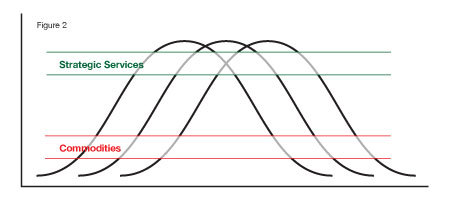 The other strategy to find centers of influence is to network laterally, as seen in Figure 2. This means looking to alternative industries that have equivalent buyer relationships.
The other strategy to find centers of influence is to network laterally, as seen in Figure 2. This means looking to alternative industries that have equivalent buyer relationships.
For example, an accounting firm may build centers of influence with lawyers, insurance brokers, and bankers. If the partners are non-competitive and have similar influence in the buying continuum they can become excellent centers of influence for each other.
Depending on where you sit on the curve you may choose one or both strategies to find your centers of influence.
The Influence Curve for Marketing Services
Let’s look at an example from the marketing industry, visualized in Figure 3.
For a few years I participated in a business networking group that met weekly for a breakfast meeting. The group had a strong marketing contingent: a web developer, a graphic designer, a print broker, a copywriter, a search marketing agency, and me — the brand strategist.
Each company is an expert in its field, and they are all very good at what they do. But their influence on the buying continuum varies broadly.
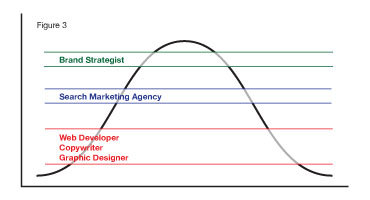 At the bottom of the Influence Curve are the transactional marketing services: graphic design, web development, and copywriter. These companies have a large volume of clients and tend to receive lots of referrals.
At the bottom of the Influence Curve are the transactional marketing services: graphic design, web development, and copywriter. These companies have a large volume of clients and tend to receive lots of referrals.
In the middle of the curve are integrated solutions providers and agencies (digital, PR, and advertising). These organizations sell more complex services, and have a broader perspective of their clients. This is where the search marketing agency sits, and they often subcontract work to the web developer and graphic designer.
At the top of the curve is the brand strategist. The strategist has the broadest view of the client’s organization, and their client relationships are primarily with executive teams.
From a networking context the centers of influence are above you. The web developer and designer can develop COIs with the search agency or the brand strategist. These marketing providers will have the pulse of the client and can quickly recommend their expertise when the client has a need.
The search marketing agency’s center of influence is the brand strategist. The web developer and designer just don’t have the same view of the client’s organization, nor the same type of relationships. The brand strategist on the other hand does.
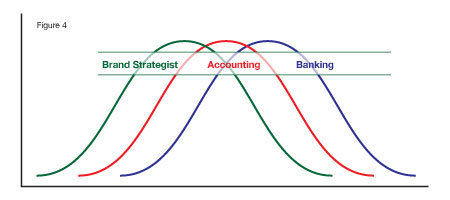 In the Influence Curve the brand strategist has the problem, because they are at the top of the curve. Their only networking strategy is to develop COIs laterally, seen in Figure 4.
In the Influence Curve the brand strategist has the problem, because they are at the top of the curve. Their only networking strategy is to develop COIs laterally, seen in Figure 4.
In my networking group I found I was a good referral partner for the other marketers, but my centers of influence were from unrelated industries: a partner of a mid-sized accounting firm, a management consultant, and a corporate banker.
By networking laterally I focused on finding COIs that had similar client relationships, similar perspectives of our clients’ organizations, and our services complemented each other.
Referrals Travel Down the Influence Curve
The Influence Curve reveals a truth about networking: referrals travel down the curve.
People and companies, generally speaking, do not refer up the curve. This happens for three reasons.
First, perspective. The Influence Curve is like a mountain. The higher up the curve the more you can see.
Companies that sell strategic solutions have greater access to the executive team, they see more of the company, and they can spot more opportunities. While companies that are lower on the curve tend to have a more specialized or transactional view of their clients — they see their domain.
For example, a web developer only sees a portion of a client’s marketing program whereas the brand strategist has access to the big picture. The strategist will generate more referrals for other service providers because they can see more of the mountain.
Second, priorities. Ironically the transaction size increases the lower a firm is on the curve. For example, it’s a lot more expensive to build a building than to have one designed. As a result, firms lower on the Influence Curve will often bundle strategic services with their overall packages. This happens across industries, and strategic expertise is “given away” in the bidding process to win sales.
Third, fear. When another service provider refers to a provider above them on the curve it feels like they failed.
Companies want to do good work for their clients. They’ll adapt their services, give advice, and do what they can to help their clients solve problems. Acknowledging that the client’s situation is no longer a fit is hard to do and puts the account in jeopardy.
For example, the web developer could be displaced if they suggest the client engages a firm higher on the curve. This may not happen, but there’s always a chance that a change in the strategy will ripple down the organization and eliminate the need for their services.
Spot the Outliers
As with any rule there are exceptions. There are people that refer up the curve, but they are a special breed.
The people who refer up the curve display four traits:
An unusual curiosity and insight into their industry. They are the students of their industry and understand all its moving parts.
High degree of self-awareness. They know what they do best, and they know what their company does best. This can also be a sign that they already have a successful business, and can be selective in the clients they take on.
Secure in their position. They are not threatened by the competition, and naturally refer away anyone who is not a direct fit for their services.
Natural networkers. The outliers know a lot of people, and they are constantly making new connections. The volume of connections they generate makes it easier for them to make more referrals.
These individuals do exist, and you’ll often find them in senior positions in firms. They are the “rainmakers.” It’s always good to know these individuals, but they are hard to find consistently.
Chutes and Ladders
The networking strategy for the Influence Curve is like Chutes and Ladders.
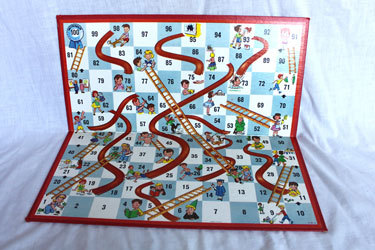 Chutes and Ladders — also called Snakes and Ladders — is a board game of chance. Your objective is to climb up ladders to reach the top of the board, and avoid chutes that send you downwards.
Chutes and Ladders — also called Snakes and Ladders — is a board game of chance. Your objective is to climb up ladders to reach the top of the board, and avoid chutes that send you downwards.
In the networking arena companies try to adapt their brand, value proposition, and services to support their shotgun approach of networking. They attempt to create a universally appealing value proposition that will resonate with anyone they pitch.
For example they might:
“Dumb down” their messaging so it speaks to everyone.
Create “starter packages” that are in line with the services of the firms below them on the Influence Curve.
Avoid both options. Branding 101 dictates that you can’t serve everyone.
Networking with firms below you in the Influence Curve doesn’t work for two reasons:
Weak Positioning: If you get referred as a transactional service you stay a transactional service. You’re not positioning your brand properly.
Differing Perspectives: Firms that are below you on the Influence Curve have different client relationships. They may know the right people, but may not have the perspective necessary to make a referral.
Developing COIs below you on the Influence Curve is like stepping on a chute — they hinder your progress. You’re objective is to climb the ladders: go up or go laterally.
Network With Purpose
Finding the right referral partners makes selling so much easier. They advocate for your business. They introduce you to new connections, and they help you move the sales needle.
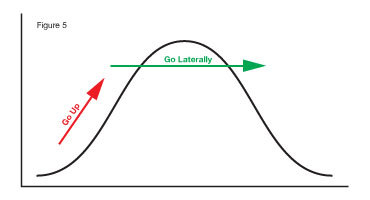 The challenge is finding these centers of influence.
The challenge is finding these centers of influence.
The shotgun approach to networking is tried and true. If you kiss enough frogs you will find a prince, I guarantee it.
But if you’re tired of kissing frogs, change your game. The Influence Curve is your map to discover centers of influence for your business. Once you know where to look COIs are a lot easier to find.
Go high or go laterally. You’ll find centers of influence in both directions.
September 1, 2015
Ultra Long Form Content: It’s a Home Run
Ultra long form content performs well — surprisingly well. It generates more website traffic, social media engagement, and search engine value.
For the past four weeks I have been running an experiment with ultra long form content. I wanted to see how long articles perform compared with normal blog posts — 2,500+ word articles compared to 500 word articles.
The initial results are better than expected. The metrics are all pointing upwards, and it appears ultra long form content is a home run.
Website Performance Improved
Across the board the metrics are up in Google Analytics.
August 2015 compared to July 2015

Sessions increased 19.21%
Unique Visitors increased 14.18%
Page Views increased 24.75%
This was interesting because I published 50% less content, but the ultra long form content generated far more activity than average posts.
August 2015 compared to August 2014

Sessions increased 118.13%
Unique Visitors increased 106.39%
Page Views increased 112.26%
Comparing the results from this time last year casts an even better picture. The numbers are way up, but I think this demonstrates how the platform has grown more than how long form content performs.
All About SEO
What separates the ultra long form content from average posts is their search value.
Writing an essay forces you to be deliberate about its thesis. An essay is a deep dive into a specific topic, and Google loves that.
The four ultra long articles I shared all had clear keywords:
Brand Symbols
Brand Mascots
Brand Metaphors
Since these articles are 2,500+ words the keywords are used repeatedly. For example, “brand metaphor” is used twenty-three times in the body of Brand Metaphors: How to Engage Customers at a Deep, Visceral Level.
It’s still early days, but I am sure all four of these articles will perform very well in the coming months based on their keyword density.
Social Media Engagement
Ultra long form content performs well in social media.
Comparing August 2015 to July 2015, social media shares increased 17%. This was across the board on Twitter, Facebook, and LinkedIn. And my article on Brand Symbols received two times more shares than anything else I’ve published in the last six months.
These results are validated by others. For example, Neil Patel at QuickSprout found articles with 1,500+ words generate more shares on Twitter, Facebook, and LinkedIn.

Medium.com’s metrics show that articles that take seven minutes to read (roughly 1,600 words) generate the highest levels of engagement.
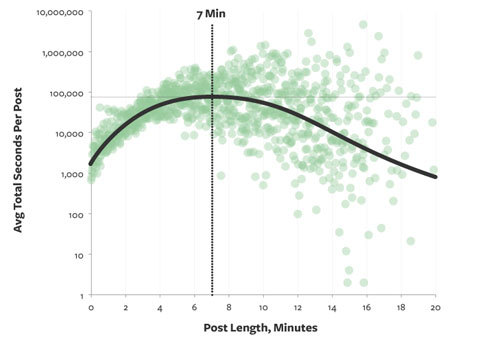
The Catch
As much as the data presents a rosy picture, these articles come with a caveat. They’re a hell of a lot of work to create.
Brand Metaphors was the quickest to write at fourteen hours, and Brand Symbols took the longest at twenty eight hours.
This makes sense considering each article is the equivalent of five normal blog posts, but this is still a huge time commitment for a blog. Trying to crank out ultra long form content on a weekly basis may not be sustainable.
The Takeaway: Swing for the Fences
The results are clear: ultra long form content performs very well. It generates more website traffic, it has high search value, and it generates more social media engagement.
I am a little taken aback that the numbers are so high. I wasn’t expecting such big jumps.
My key takeaway: don’t write off long form content. It may seem counterintuitive to publish really long pieces of content. The assumption is “people don’t read,” but the data is painting a different picture.
To paraphrase Jay Baer, swing for the fences. Jay argues, “80-90% of all blog traffic comes from 10-20% of the posts you publish … Stop publishing blog posts that are almost assuredly going to be strikeouts, and instead publish more blog posts that have a chance to become home runs.”
Average content may not be enough to engage your audience anymore. Ultra long form content is not necessarily the answer, but it may be the first step to retool your content marketing to generate more home runs.
What do you think?
August 27, 2015
Brand Metaphors: How to Engage Customers at a Deep, Visceral Level
Every great brand has a discernible tone. It’s a theme that’s linked to the brand through the decades. No matter how the brand evolves or changes the tone doesn’t change.
This tone is a brand metaphor. We usually think of metaphors as explanations or comparisons. For example, “our office is a zoo” or “time is money.” These are surface metaphors. They are broadly used in everyday language, and an integral part of how we communicate.
Brand metaphors operate at a much deeper and less obvious level than surface metaphors. You may not be consciously aware of them, but as soon as they’re pointed out they become obvious.
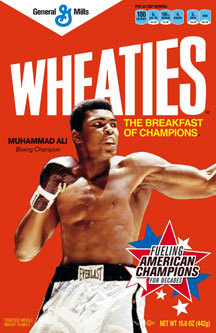 Wheaties cereal is “the breakfast of champions.” Not only does this positioning connote where Wheaties sits in the hierarchy of cereal brands, it suggests what this cereal will do for you.
Wheaties cereal is “the breakfast of champions.” Not only does this positioning connote where Wheaties sits in the hierarchy of cereal brands, it suggests what this cereal will do for you.
Its packaging features world class athletes. Over the years the cereal boxes have featured Muhammad Ali, Michael Jordan, Bruce Jenner, Tiger Woods, and Michael Phelps. Wheaties’ brand metaphor is winning, especially in the field of athletics.
Chevy trucks are “like a rock.” Gerald Zaltman, author of How Customers Think, explains, “When consumers make a connection between the idea of a Chevy truck and the idea of a rock, they attribute certain rocklike qualities, such as the ability to take abuse, to Chevy trucks and translate them into notions of reliability and ruggedness.”
“The breakfast of champions” and “like a rock” are more than creative advertising campaigns and taglines. They are ideas based on brand metaphors. We connect with these brands at a deeper more visceral level because they go beyond marketing platitudes.
“Like A Rock” Articulates What Consumers Believe
“Metaphors do not exist as words in memory, but as networks of abstract understanding that constitute part of our mental imagery,” writes Zaltman.
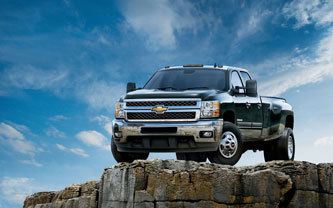 The “like a rock” campaign is effective, because it’s based on the customers’ belief of what Chevy trucks provide. To develop the campaign Chevy went through a metaphor-elicitation process.
The “like a rock” campaign is effective, because it’s based on the customers’ belief of what Chevy trucks provide. To develop the campaign Chevy went through a metaphor-elicitation process.
Chevy asked a group of consumers to bring in pictures to describe their vehicles. The consumers were asked to find pictures that depicted their thoughts and feelings about their trucks without showing them. They could use whatever picture they wanted as long as there were no other trucks, cars, or motorized vehicles in them.
As consumers brought forward their pictures and stories a set of themes emerged: reliable, takes abuse, rugged, tough, and dependable. Consumers weren’t sharing stories about the leather interior or the truck’s horsepower and torque. They were talking about the physicality of the truck.
The phrase “like a rock” came from Bob Seger’s iconic song. Julie Halpert explains, “Don Gould, Campbell-Ewald’s truck creative director [working on the Chevy account], was listening to a Bob Seger album and heard the song ‘Like a Rock.’ He thought it was a perfect way to embody the truck’s toughness, and also suggested the owners were strong and self-reliant.”
The song embodied consumer sentiment down to a T. The lyrics described the pictures consumers brought forward in the metaphor-elicitation research:
Like a rock, I was strong as I could be
Like a rock, nothin’ ever got to me
Like a rock, I was something to see
Like a rock
Like a rock. standin’ arrow straight
Like a rock, chargin’ from the gate
Like a rock, carryin’ the weight
Like a rock
Like a rock, the sun upon my skin
Like a rock, hard against the wind
Like a rock, I see myself again
Like a rock
The campaign was an immediate hit. Jeff Hubert, Chevy’s marketing director, remarked, “The people reacted so positively to it that we knew we had a home run.”
Brand Metaphors Breakaway From Shallow Marketing
Brand metaphors break away from the traditional approach of marketing features and benefits.
Marketers often focus in on the nuances of what makes their products and services different from the competition. These differences could be a new feature, a branded service offering, or their location.
These may seem like big differences from the marketer’s point of view, but from the customer’s perspective these differences are rather inconsequential. Zaltman calls this the “seduction of differences.” It’s easier to explain how you’re different than to demonstrate you are different.
Brand metaphors require deeper thinking:
What do your products and services represent for your customers?
How do you deliver value?
What place does your brand fit in your customers lives or businesses?
How does your company behave differently from your competitors?
What’s it like to work with your company?
The tone of your business is more important to market than the features and benefits because it’s a constant. But this can be a tough sell internally.
Your team has invested in creating products and services that are different. You’ve built capabilities that no one else has. But brand building is more opaque than we’d logically like to accept.
Ninety-five percent of all cognition occurs below your awareness. This is known as the 95-5 split. You’re only aware of five percent of your thinking, and this is where the features and benefits arguments reside.
Ninety-five percent of your decision making is happening below the surface. It’s “how you feel” about a product or company. It’s “what you believe” it will do for you. This is the area of the brain marketers have to engage, but it’s hard to develop campaigns and programs that are designed to engage the subconscious.
Management teams often reject “airy fairy” campaigns, because they can’t quantify what they will do or what they are selling. Brand metaphors are your tool to create marketing that sells while engaging customers at a more base level. Brand metaphors break through the conscious and engage the subconscious.
Chevy truck owners resonate with “like a rock,” because it consciously conveys what their subconscious is feeling. It also pleases the leadership team, because it articulates the positioning and core features of the products.
Seven Deep Metaphors
There are universal metaphors that span countries, cultures, languages, and dialects. Gerald Zaltman calls them the seven giants:
Balance: The idea of keeping things “as they should be.” People talk about balance in many ways. Your diet can be “out of balance.” You may be striving for “work-life balance.” Balance includes physical, mental, social, psychological, or even aesthetically.
Transformation: Transformation involves changing states or status. It’s the caterpillar transforming into a butterfly. Transformation is about change, and we might consciously seek it or avoid it.
Journey: Journey is a core idea and can be physical, social, or psychological. Your career is a journey, and you could be “stuck,” “leapfrogging positions,” or working “towards retirement.” Robert Frost said, “Two roads diverged in the wood, and I took the one less traveled.”
Container: Containers keep things in like Tupperware, or they keep things out like a moat around a castle. The privacy debate around social media and the Internet is an example of a container metaphor. We prize our privacy, and we’re concerned who has access to it.
Connection: Connections are personal. We express ownership of our things. For example, “I love my car.” We also express disconnection or loss when someone close to us passes away. Connection brings up ideas of marriage, children, kids going off to college, and giving and receiving gifts.
Resource: We need resources to survive: food, water, air, even a mother’s love. Your smartphone is a resource. People often describe themselves as “feeling naked without it.” We have mentors that are a “fountain of knowledge.” Resources are the things we need.
Control: Control may be the most visceral of the deep metaphors. As humans we crave control, and we feel very uncomfortable when we lose control. People may feel “powerless” when confronting a bad boss. We have laws and morals to help us establish control. When things are going well you might say you’re on “autopilot.”
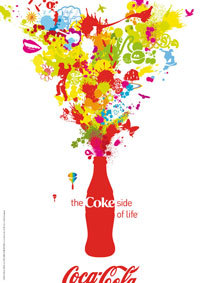 Zaltman explains in Marketing Metaphoria, “Deep metaphors are enduring ways of perceiving things, making sense of what we encounter, and guiding our subsequent actions.”
Zaltman explains in Marketing Metaphoria, “Deep metaphors are enduring ways of perceiving things, making sense of what we encounter, and guiding our subsequent actions.”
The seven deep metaphors are the building blocks of brand metaphors. Coca-Cola’s brand is anchored on the deep metaphor of transformation. Coke transforms you. It gives you energy and it refreshes you. Coca-Cola brings its brand metaphor to life with campaigns like “Open Happiness” and “Twist the Cap to Refreshment.”
Coke is signalling to consumers that its brand delivers energy and vitality, which will transform your life for the better.
Discover Your Brand Metaphor
Finding your brand metaphor is a fun process. It’s an exercise I run frequently with clients, because it leads to deeper insights and creativity into what their brand represents.
Getting Started: To discover your brand’s metaphor recruit five to twenty five customers to participate in the project.
This is often the most challenging step, because you may perceive that your customers are too busy to participate. Ask anyways. It’s always surprising and encouraging to see how many of your customers will be glad to help out.
The Task: Ask each of the participants to tell a short story of your company, product, or service. Their story could be about how they first found your company, and how they felt about the experience. It could be a story about how they use your products and services, and the impact they’ve had on their day-to-day lives.
Let them pick. Ask them to tell a meaningful story about their experience working with your company, product, or service.
The Catch: This project has a small catch. Instead of having the participants tell you a story, have them tell it with pictures. Ask each participant to find a series of pictures to visualize their story without using any pictures of the product or service.
Have them think of this as a slideshow. Ask them to find five to twenty images to tell their story. They can print the photos, or they can arrange them in PowerPoint (or another presentation tool).
The pictures are the key to this exercise, because it helps the participants to be more descriptive with their experiences. They will use more colorful language and make it easier for you to hear their metaphors.
Interview the Participants: The next step is to interview each of the participants and have them deliver to you their story. Give them at least fifteen minutes, and ask them to be as thorough as possible.
Have fun with the process. Let them share an epic tale. Probe them to go deeper. Ask them why they chose each image. Get them to dive as deeply as possible into the story.
Shut Up and Listen: Interviewing is a skill. Go into the process with a commitment not to talk. Don’t interject with your opinions. Don’t challenge the participant. Don’t add your two cents.
Listen. Observe. Ask questions.
As the participants are sharing their stories listen for details and take notes. Write down the words or phrases they use. Document their story as it unfolds. Try not to judge or fill in any other details. Just listen, observe, and be present.
Find Common Phrases: Review your notes after each participant has completed their story. Look for common phrases, metaphors, or descriptions. Circle all of them.
Then roll-up your findings and see what trends emerge from the group. What did the participants’ stories have in common? What phrases were used frequently? How were the participants’ examples similar, and how did they differ?
Look for the nuances to get a deeper understanding of your brand.
Identify the Deep Metaphors: Once you have completed your analysis of the group try to link the phrases and stories to Gerald Zaltman’s seven deep metaphors: balance, transformation, journey, container, connection, resource, and control.
You may find several of the deep metaphors emerge. This is where you can start interpreting the results and deciding which metaphors are most relevant for your brand.
The objective is to reduce the descriptions and select a metaphor. If there are more than one that fits you can select a primary and a secondary deep metaphor, but no more than two. The most meaning is delivered when you are clear about which deep metaphor your brand is closely associated with.
Applying Brand Metaphors
In each of my businesses I have anchored the brand on a deep metaphor. LEAPJob’s deep metaphor was journey. Sticky Branding’s deep metaphor is transformation.
When we were going through the rebranding and for LEAPJob we used the exercise above. Throughout the interviews participants described their career and job hunting like a journey. Some participants used phrases like “I’m stuck,” or “I’m not getting the promotion I expected.” Others talked about “changing directions” or going down “new paths” with a new job.
We move towards retirement, or pursue a promotion. Some steps on a career come quickly, and others stop us dead in our tracks. This is the language of a journey.
We built the brand metaphor right into the company’s name, LEAPJob. We developed the brand positioning, imagery, and customer experience on the metaphor of “leaping forward.”
Sticky Branding, on the other hand, has a very different objective. Branding can be a journey, but that’s not what we’re all about. We focus on the deep metaphor of transformation, because Sticky Brands evolve.
The “sticky” in our name isn’t about glue or being stuck, it’s about attraction. How do you make your business more appealing? How do you stand out like an orange tree in an evergreen forest? How do you become your customers’ first choice? These are the questions Sticky Branding solves, which are all grounded in the metaphor of transformation.
Understanding where the metaphor fits helps us define our services, the types of clients we help, how we deliver value, and how we tell our story.
The brand metaphor becomes the root of your brand. It centers your business and focuses your creativity. Instead of coming up with unique storylines for each new product feature or campaign, you can continue to build upon the root. You get to ask again and again, how do we articulate the brand metaphor so that it’s clear, obvious, and easy to understand?
Brand Metaphors Outlive the Strategy
Brands have a shelf life, but brand metaphors are static.
A brand’s positioning and value proposition typically has a shelf life of three to seven years, depending on the industry. Consumers brands shift far more rapidly than industrial brands, but regardless of the industry every company changes.
The beauty of brand metaphors is they don’t change. The way you express or articulate the brand metaphor may change, but their core meaning and presence is a constant.
Coca-Cola has owned transformation from the beginning, which makes sense considering the original formula included caffeine and cocaine. Coke was the original energy drink with an extra kick. In 1903 cocaine was removed from the Coca-Cola recipe, but the roots that Coke is refreshing and gives you energy has remained constant.
With the right brand metaphor you can deliver meaning and relevant customer experiences for generations to come. The brand metaphor outlives the strategy, and becomes the one constant of what your brand represents — no matter the timeframe.
August 20, 2015
Brand Naming Process: How to Make a Brand Name Resonate
A brilliant name is the basic core differentiator of your brand. It helps to build awareness and convey meaning.
What would Apple be without its name? There are plenty of innovative technology companies around the world, but Apple has the brand. The name provides a platform for the brand, and it’s the first indicator that this company thinks differently.
The name garners Apple a great deal of power, because it resonates with consumers. It’s a mark of trust. David Aaker writes in Managing Brand Equity, “A name can serve as a substantial barrier to entry once it is established. Consider the power of names like Velcro, Formica, and Kodak. In fact, a name can be more useful than a patent, which can be difficult and costly to defend.”
A brilliant name sets the stage for the brand. This becomes evident when you read the lists of the Top 100 brands. You see names that immediately evoke meaning and trust: Google, VISA, Coca-Cola, Facebook, Amazon.com, Disney, Starbucks, Subway, FedEx, Red Bull, Twitter, and Shell.

Without any other description or explanation you know these companies. You know what they are, what they represent, and where they fit (or don’t fit) in your life. The brand name is the container of meaning. We may know the brand symbols or its mascot, but we reference and talk about its name.
That’s why naming your brand is so important. The brand naming process isn’t something you delegate to a committee or a few brainstorming sessions with your agency. Naming your brand — whether it’s your company, products, or services — is a decision that can shape the future and trajectory of your business.
In this article you will find an introduction to a brand naming process. You will learn a systematic approach to generating and selecting brand names, and how to test them. It’s a proven approach, but it does take time and creativity to get it right.
Four Types of Brand Names
The beauty of naming your brand is it rewards creativity.
There’s a lot of flexibility to generate and select the right name for your brand. You can invent a word like Twitter or Kodak. You can use a descriptive name like PayPal or Toys R Us. You can even name the brand after the founder like John Deere or J.P. Morgan.
You’ve really got a lot options. There are four primary categories of brand names.
Descriptive Name: Indicates what the company, product, or service is or does.
Descriptive brand names are the oldest class of brand names. John Deere, for example, is the brand name for Deere & Company. The company was founded in 1837 and the name is derived from its founder.

Descriptive names are also effective for describing the business. PayPal is a payment company. Subway serves submarine sandwiches. These names clearly position the brands and make it easier for consumers to identify their products and services and when to choose them.
The pitfall of a descriptive name is it can be constraining. For example, Salesforce.com was founded as a CRM software provider focused on salesforce automation. The company has evolved dramatically into a cloud computing company. It offers a variety of applications that reach well beyond sales teams. The company’s name is far less relevant than it was in 1999.
Acronyms: An abbreviation of a descriptive name.
Many of the world’s most recognized brands are acronyms: GE, UPS, IBM, SAP, HP, and TD, to name a few.

Most acronyms evolve out of functional names. Either deliberately or organically, descriptive names can be paired down into bite size chunks. For example, it’s easier to say AFLAC than American Family Life Assurance Company, or GEICO than Government Employees Insurance Company.
An acronym can be quick to say, easy to remember, and easier to trademark. But, and this is a big but, they lack a soul.
The primary pitfall of acronyms is they are empty vessels. They don’t draw from any other words in our lexicon, and even with a lot of use acronyms don’t absorb much meaning. They are just a grouping of letters.
Invented Names: A made-up word.
Some of the most iconic brands are invented words: Kodak, Xerox, Acura, Google, and Twitter. They are names created specifically to represent a brand.

Invented words are very powerful, because they don’t come with any baggage. They are empty vessels designed to represent a brand.
But using invented words is very tricky. Not all invented words make compelling brand names. It’s best to avoid invented names with Greek or Latin roots such as Verizon, Cingular, or Agilent. According to Steve Manning, founder of the naming company Igor International, “Because these types of names are built on Greek or Latin morphemes, you need the advertising budget of a gigantic global corporation to imbue them with meaning and get people to remember them.”
For example, in 2002 Cingular spent over $428 million on advertising. This was only two years after the company was founded.
The best invented brand names are based on poetically constructed names. Twitter evokes the experience of communicating rapidly in 140 characters. Google resonates with the act of searching and discovering. Kodak demonstrates strength and being in the moment.
Manning explains, “By design, the target audience likes saying these [poetically constructed] names, which helps propel and saturate them throughout the target audience.”
Experiential Names: Build upon what the feeling or experience the brand delivers.
Experiential names are the most powerful class of names. This is where the most iconic brands stand: Apple, Virgin, Caterpillar, and Oracle.

These names are positioning statements. They help a company stand out in their marketplace by setting an expectation of what it’s like to choose them.
The biggest obstacle of generating an experiential name is connecting meaning to the brand. This requires a deep understanding of your business and what it stands for before the naming process begins. If the name is out of sync with the positioning of the business it loses impact.
Map the Competition
Before you start brainstorming or putting pen to paper, the first step is to map the competitive landscape for your brand.
To begin your naming project develop a comprehensive list of all the competitors to your brand. Consider both direct and indirect competitors. As you collect the names divide them into four categories:
Descriptive
Acronyms
Invented
Experiential
Once you have an exhaustive list look for trends:
What are common words or phrases?
What are the naming conventions? For example, do competitors congregate in one category more than the others?
What attitudes or beliefs do the competitors’ names evoke?
Which brands stand out most and why?
By mapping the competitive landscape provides two benefits for your brand naming process. First, it lets you see what you’re up against. Second, a clear picture of the playing field will help you develop guidelines for your naming project.
Establish Brand Naming Guidelines
Naming your brand is strategic. It’s going to be a part of your business for a long time.
The next step in the brand naming process is to define what your name will represent and how it will support your business. This starts with what you are naming. Is it a product, service, or the business itself? What you name will influence how you name it.
In 2004 I led the rebranding of my family’s recruiting business, Miller & Associates. I shared the background on this rebranding project in the preface of my book, Sticky Branding. The company was being repositioned from IT staffing to sales and marketing recruiting, and we were developing a fresh new identity.
To rename Miller & Associates we established a few guidelines. The new name had to be:
Simple to say, easy to remember
Short, ideally less than 8 characters
Have a .com domain name
Could not use the words “recruiting, “recruiter,” or “staffing”
These guidelines were established based on what kind of brand experience we wanted to present to our customers, and how we wanted to differentiate our company from the competition.
When you are naming your brand — whether it’s a company, product, or service — establish your guidelines. How do you want your brand name to perform? What rules should the name adhere to? What are areas you want to avoid in the naming process?
Notepads, Sticky Notes, and a Thesaurus
Generating names is a creative process, and works best if you give yourself the freedom to explore. Start wide and build lists of names.
 To rename Miller & Associates I relied on three tools: notepads, sticky notes, and a thesaurus. I’d search the thesaurus for interesting words, and then create as many word combinations as possible in my notepad. Every time I found an interesting word pairing I’d write it on a sticky note and tack it on the wall.
To rename Miller & Associates I relied on three tools: notepads, sticky notes, and a thesaurus. I’d search the thesaurus for interesting words, and then create as many word combinations as possible in my notepad. Every time I found an interesting word pairing I’d write it on a sticky note and tack it on the wall.
I also explored invented words. I invented words in two ways. First, I pretended to talk in gibberish and grabbed words or statements that I found compelling. I also explored combining words and strong syllables. Again, every interesting name went on a sticky note and was placed on the wall.
I didn’t generate any brilliant names on my first few tries. It was a process. For the better part of six weeks I spent twenty minutes a day generating names. I focused my efforts on generating evocative, descriptive, and invented names.
At the end of the process I had filled dozens of notepads, and had twenty potential names on sticky notes. This was a good starting point.
You may have a different approach to generating names, but my key recommendation is to let yourself explore freely in the name generation phase. Generate lots of options. Push yourself beyond the obvious. Explore lots of words, phrases, and ideas.
A brilliant name may show itself quickly, but chances are it’s far deeper in the cycle.
The Domain Name Wrinkle
A key decision in the naming process is to determine if the brand requires a domain name. If you’re naming a company you can guarantee a domain is required. With a product or service you may have a bit more latitude, and not need a domain name. The domain name requirement all depends on how you will market and promote the brand.
Finding an available .com domain name is very hard, unless you are working with invented words. Even finding domain names for unique word pairings is extremely challenging. It’s almost a given to assume all the good names have been registered, but that doesn’t mean all the domain names are being used.
In many circumstances you can purchase domains that have already been registered. That’s what I did with Sticky Branding. I purchased StickyBranding.com and StickyBrands.com from two different people. There are vibrant marketplaces like GoDaddy Auctions and Sedo where you can buy domains.
If having a domain name is important I recommend setting aside a budget to purchase domain names. For a small business I recommend a budget of $2,500. For consumer oriented brands, or brands that will engage a large audience, I suggest a budget of $25,000. The basic logic is simple. A great name will more than pay for itself in the long run.
Short List of Brand Names
You can test every name on your list, but it’s a good idea to cull the list before you go further.
To help select my top three names I engaged five people to pick their five favorites from my list of twenty names. I collected the lists from each person, and then looked to see which names rose to the top.
Three names emerged as potential brand names:
Fox Hunt, an experiential name
AYA, an invented name
LEAPJob, a descriptive name
At this point we did a gut check. AYA fit our brand guidelines, but it lacked something. It didn’t stack up to the other two names so we ditched it.
The short list can be a humbling moment. You may hit this stage and realize that none of your names are good enough. It happens. It’s a natural part of the brand naming process. The key is to not let this setback hold you back. Avoid compromising by selecting one name just because it’s there. Go back to the name generation phase if none of your names are good enough.
Committees Kill Names
It’s worth pointing out that committees are the bane of creativity. Don’t let them slip into your naming process at any stage.
Choose your naming team deliberately. Who is generating names? How are you testing names? Who is helping to select the short list? What qualifications do these people bring to the process?
Build your naming team early on. There’s nothing more frustrating than having a dozen voices and no way to move forward.
Five Characteristics to Test Your Brand Name
Do a quick assessment of your brand names, and consider each by five characteristics:
Distinctive: How does the name stand out amongst the competition?
Sound: Say the name out loud. How does it sound? Is it easy to say? Is it poetic?
Stickiness: Is the name easy to remember? How many times do you have to hear it before you remember it?
Expression: Does the name demonstrate what your brand is all about? Does it fit your brand’s personality?
Appearance: What does the word look like in print? Does it look as good as it sounds?
A brilliant brand name will excel in all five characteristics.
The Helvetica Test
To test the appearance of your brand name print the name in capital letters in Helvetica Neue Bold. What you are looking for is the balance and readability of the name. How does the name look in a standard sans serif font?
If you’re deliberating amongst a handful of names you can print each name on a piece of paper. Print each name in huge characters so it fills up the page.

Hand the pages out to people and ask them two questions:
What do you think of when you read each name?
Which name is your favorite and why?
A few days later circle back with each person and ask them to recall the names you shared with them. Take note of which names they remember, and how quickly and easily they were able to recall the names.
The more people you can have complete the test the more insights you will gather.
The Logo Test
If you’re happy with the name and it’s resonating with your test subjects, the next step is to develop a logo.
A logo will help you prove the visual impact of your name.
To test LEAPJob and Fox Hunt we developed two logos. The Helvetica Test left us with a split audience. People liked both names equally, and we weren’t sure which way to go. The logo test helped us break the tie.

Once in a logo the LEAPJob name won. Many people found the name Fox Hunt evoked ideas of blood, guts, and animal cruelty. Those were not connotations we wanted associated with our brand.
LEAPJob was built on the metaphor of leapfrogging, and it played on the idea of leaping forward in your career. The leaping frog struck a chord with our audience.
A visual test helps you to distinguish your brand, and proves this is the name you want to represent your company, product, or service.
Mix and Match Logos and Wordmarks
The neat part of developing several names and logos is you can mix and match the best elements of each.
 Lululemon’s brand identity came from mixing and matching logos and names during the naming process. The company explains, “The lululemon name was chosen in a survey of 100 people from a list of 20 brand names and 20 logos. The logo is actually a stylized ‘A’ that was made for the first letter in the name ‘athletically hip’, a name which failed to make the grade.”
Lululemon’s brand identity came from mixing and matching logos and names during the naming process. The company explains, “The lululemon name was chosen in a survey of 100 people from a list of 20 brand names and 20 logos. The logo is actually a stylized ‘A’ that was made for the first letter in the name ‘athletically hip’, a name which failed to make the grade.”
The benefit of generating a lot of options is it gives you more to work with. You never know where inspiration will strike. You may find elements of one name or logo really stand out. By combining them you can create something iconic.
Brand Naming Takes Patience
The biggest obstacle to selecting a brilliant name for your brand is time. Many companies aren’t willing to put in the time or resources necessary to choose a name that will empower their brand. This is a mistake.
If you’re going to build a Sticky Brand, do it right.
The project management triangle argues quality is derived from two of three criteria:
Time
Resources
Cash
If you don’t have the time or the resources to invest in the naming process it’s going to cost you. This is when you need to hire a naming agency and set aside a substantial budget to acquire domain names. The agency brings forward the resources necessary to get the job done.
If you don’t have cash you’re going to have to invest the time and resources to find and test a brilliant name. That’s how I named LEAPJob and Sticky Branding. They were both DIY projects, because I didn’t have thousands of dollars to hire additional resources.
The best course of action is to give your team the time and space they need to explore and test names. Ninety days is a good time frame. This doesn’t mean your full time job is to generate and test names. Rather budget an hour a day to work the process.
By investing the time to get it right can make all the difference in the world. A brilliant brand name can set the foundation for your business to be a leader in its category.
August 18, 2015
Ultra Long Form Content: A 30 Day Test
You may have noticed my last two articles — on brand icons and brand mascots — have been long. Really, really long!
This was deliberate, and I’d like your input on it.
For the month of August I am running a content experiment. Instead of publishing two short articles per week, I am publishing one in depth article per week.
We’re half way through the experiment, and I’d like to take this opportunity to bring you up to speed.
Why Long Form Content
The idea for this project came from the 2015 Reader Survey. (The survey is still open if you haven’t shared your thoughts yet.)
Several people made suggestions that they’d like me to go deeper on some core branding topics. Rather than doing more of the same I am shaking things up with a few long articles.
Here’s what I am testing and hoping to accomplish:
1. Test Long Form Content Impact
I have heard anecdotally from Tim Ferriss and Gini Dietrich that long form content performs better over time. It may not launch to a ton of attention, but longer posts tend to generate more inbound links and higher search value. Within a year or two these articles generate a lot more website traffic than the shorter posts.
The first question: does long form content have greater SEO value than shorter posts?
2. Personal Development
Writing 2,500 word articles (8 – 10 pages) takes a lot of planning, research, and thought. They also require a different style of writing. Long form content applies different storylines and communication structures than shorter pieces, because you have to keep the reader’s interest over a much longer duration.
This is a personal challenge for me. Writing these massive posts is pushing me to develop my skills.
3. Deliver Value — Lots of Value
The third objective is the most important one. The purpose of these articles is to give you interesting, useful ideas that you can apply to your brand. These articles are more than opinion pieces or brain candy. They’re written as thorough explorations of a topic.
You’ll have to tell me if these posts are delivering you value.
Measuring the Performance of Long Form Content
To measure the performance of long form content I am tracking:
Website Visitors and Time on Page
Email Opens and Clicks
Social Media Shares
Inbound Website Referrals
I am comparing these metrics to the prior 30 day period, as well as to this time last year. I’ll report the results of this experiment in September.
Are there any other metrics you’d like to see?
Qualitative Feedback: What Are Your Impressions?
The most important measure of success comes from you. In addition to the marketing analytics, I’d like to know your thoughts:
Do you like long form content?
Have you found the longer posts valuable?
Any suggestions on how I can serve you better?
Any comments or suggestions you can provide are greatly appreciated. Let’s see what we can learn together.
August 13, 2015
A Brand to Love: Brand Mascots Tug Your Heartstrings
There’s something delightful about brand mascots.
I can still picture Tony the Tiger saying, “They’re Grrreat!.” It makes me smile. The “grrreat” evokes fond childhood memories. (I even tried to audition to be a skier on a Frosted Flakes commercial. Sadly, I wasn’t selected.)
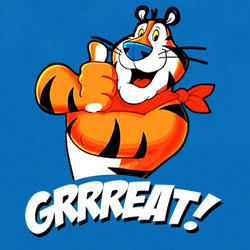 Brand mascots evoke powerful memories that can stick with you for a lifetime. Steven Heller writes, “We’re all susceptible to their lure. They infiltrate our subconsciousness, colonize our homes, and supply us with everything from food to footwear, and in return we become loyal devotees.”
Brand mascots evoke powerful memories that can stick with you for a lifetime. Steven Heller writes, “We’re all susceptible to their lure. They infiltrate our subconsciousness, colonize our homes, and supply us with everything from food to footwear, and in return we become loyal devotees.”
Tony the Tiger, the Pillsbury Doughboy, the Jolly Green Giant, and Mr. Clean are all mascots that personify their brands. They provide a character that we know, like, and trust.
Brand Mascots Personify Your Brand
A brand mascot gives your brand a human face — a face that your customers can connect with at a deep, personal level.
In Warren Dotz and Masud Husain’s stunning two volume series, Meet Mr. Product, they write, “These imaginatively conceived and illustrated product ‘spokes-characters’ personify the businesses they represent. Many of these businesses began small, but a good number grew to dominate their fields—in a large part due to their famous icons.”
 Mr. Peanut, for example, is the brand mascot of Planters Peanuts. Mr. Peanut was conceived as Bartholomew Richard Fitzgerald-Smythe by a fourteen year old boy named Antonio Gentile. Gentile’s illustration portrays an anthropomorphized peanut with arms, legs, top hat, and monocle.
Mr. Peanut, for example, is the brand mascot of Planters Peanuts. Mr. Peanut was conceived as Bartholomew Richard Fitzgerald-Smythe by a fourteen year old boy named Antonio Gentile. Gentile’s illustration portrays an anthropomorphized peanut with arms, legs, top hat, and monocle.
Gentile developed the character in response to a contest Planters ran in 1916 to source a new logo. (Crowdsourcing logos is nothing new. Planters was looking for a cheap logo ninety years before Crowdspring was founded.)
Brand mascots embody a brand’s selling points. They become a vessel of personality and meaning, and take on the qualities that a company wants to portray. Mr. Peanut personifies the premium positioning of Planters Peanuts, but with tongue-in-cheek irreverence. He’s healthy but fun.
Mr. Peanut is the life of the party. His Twitter profile describes him as a “Nut Mogul, Life Coach, World Record Adjudicator.” In commercials he comes across with a bigger than life personality, like Tony Robbins. He’s captivating, funny, and someone you want to know.
(Click here to view the video if it’s not visible.)
Brand mascots very widely from brand to brand, but they all perform the same function. They provide a human face that we can personally connect with.
Brand Mascots Give Products Credibility
Brand mascots have been an integral part of marketing and advertising for over a century because they work.
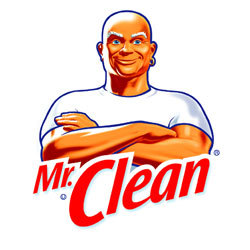 Mr. Clean was developed in 1957 by Harry Barnhart and Ernie Allen at the Tatham-Laird & Kudner advertising agency. The duo created Mr. Clean as a muscular, tanned, bald man with a single gold earring. He is the strong silent type that’s always wiping away grime.
Mr. Clean was developed in 1957 by Harry Barnhart and Ernie Allen at the Tatham-Laird & Kudner advertising agency. The duo created Mr. Clean as a muscular, tanned, bald man with a single gold earring. He is the strong silent type that’s always wiping away grime.
Since his inception Mr. Clean has always smiled. His bright blue eyes sparkle, and his eyebrows are raised as a sign of friendliness. This is a very accessible expression, and one deeply connected with the properties of the cleaning products.
With over sixty years of advertising, consumers have grown to know, like and trust Mr. Clean. And this is an immense brand asset for Procter & Gamble, owners of Mr. Clean.
In 2003, P&G introduced the Magic Eraser, a foam scrubber. It’s a neat product, but without Mr. Clean’s endorsement it’s not terribly interesting.
The Mr. Clean mascot gave these foam erasers credibility. Consumers were already familiar with other Mr. Clean cleaning products, and the Magic Eraser was a natural extension to the mascot’s range of products.
 Mr. Clean’s endorsement — which is funny to say considering he’s a cartoon character — made the Magic Eraser an immediate hit. Consumers were willing to try it, because they knew, liked, and trusted Mr. Clean. And since the product worked well it stuck.
Mr. Clean’s endorsement — which is funny to say considering he’s a cartoon character — made the Magic Eraser an immediate hit. Consumers were willing to try it, because they knew, liked, and trusted Mr. Clean. And since the product worked well it stuck.
According to P&G, “Mr. Clean Magic Eraser is a perennial fan favorite, offering an easy and convenient cleaning experience for customers.” And by 2012, Mr. Clean had sold one billion Magic Erasers.
The mascot is a brand spokesperson, and it’s reputation and likability creates a halo effect for the brands they represent. The brand mascot’s credibility endorses their products, and makes them more appealing.
Social Media Revived Brand Mascots
Brand mascots fell out of favor in the 1970s. Many of the characters that I knew and loved growing up are far less prevalent than they once were.
Dotz and Husain explain, “In the 1970s, corporate trademarks were simplified, becoming more abstract. With the growth of multinational corporations and the proliferation of corporate mergers, company names were shortened, and some ad characters that had once colorfully and boldly graced product labels and stationery were modified to stark, stylized, monotoned semblances of their former selves.”
With the rise of social media we’re seeing a resurgence in brand mascots. Social media has broken down the constraints of mass advertising and marketing, and provides personal mass communication. As individuals, we can connect with and communicate with brands and celebrities at anytime. We don’t need to simply consume what’s fed to us over the TV or radio. We have direct access.
The two-way dialogue of social media is an ideal playing field for brand mascots. Brands need to be more human than ever before, and companies are responding accordingly. Well-established, historic brand mascots like Mr. Clean and Mr. Peanut have been updated and revitalized for the social media era. You can connect with these characters on any of the social networks.
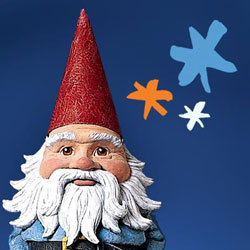 Travelocity is a modern brand that is effectively using a brand mascot to humanize its brand. In fact, the mascot outlived the company. Expedia acquired Travelocity in 2015, but Expedia is maintaining the brand and mascot. Dara Khosrowshahi, CEO of Expedia, said, “Travelocity is one of the most recognized travel brands in North America.”
Travelocity is a modern brand that is effectively using a brand mascot to humanize its brand. In fact, the mascot outlived the company. Expedia acquired Travelocity in 2015, but Expedia is maintaining the brand and mascot. Dara Khosrowshahi, CEO of Expedia, said, “Travelocity is one of the most recognized travel brands in North America.”
In 2004, Travelocity introduced “The Roaming Gnome” voiced by Harry Enfield. He’s described as “The official globetrotting ornament. Nabbed from a very boring garden to travel the world.”
The Roaming Gnome has become a cultural icon, because he connects with people directly on social media. He engages with travelers online with hashtags like #IWannaGo, #GnomeWisdom, and #MondayMotivacation.
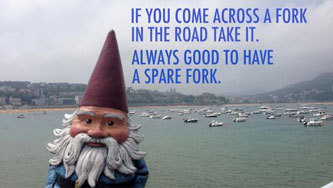 This personal interaction has elevated the Travelocity Gnome’s status, and made it a valuable brand asset. The Roaming Gnome has over 80,000 Twitter followers and 9,000 followers on Instagram. And this is for the mascot alone. The Travelocity corporate sites have even more followers.
This personal interaction has elevated the Travelocity Gnome’s status, and made it a valuable brand asset. The Roaming Gnome has over 80,000 Twitter followers and 9,000 followers on Instagram. And this is for the mascot alone. The Travelocity corporate sites have even more followers.
A well crafted character stands out in social media. It elevates the brand, and creates a focal point for its content and social media marketing. And this creates a lot of freedom for the brand, because it doesn’t have to rely on a few strategic individuals or spokespeople to build its social media presence.
Repetition Wins Hearts
Brand mascots are like fine wines, they get better with time.
A brand mascot isn’t like other marketing and advertising campaigns. They have longevity, and that’s where their real value is derived. The more your customers interact and engage with a brand mascot, the more they know it, like it, and trust it.
 When you think of some of the most popular brand mascots in North America, many have been around for decades. Mr. Peanut was released in 1916. The M&M’s characters were created with the product launch in 1941. Tony the Tiger first appeared in 1951. Mr. Clean hit the airwaves in 1958. The Pillsbury Doughboy was created in 1965.
When you think of some of the most popular brand mascots in North America, many have been around for decades. Mr. Peanut was released in 1916. The M&M’s characters were created with the product launch in 1941. Tony the Tiger first appeared in 1951. Mr. Clean hit the airwaves in 1958. The Pillsbury Doughboy was created in 1965.
These mascots aren’t just cute, creative characters. They are characters that we have grown up with. They are characters we’ve been exposed to again and again. This is their real source of power and influence. Individual experiences with a brand mascot aren’t of much value, but the more often you interact with the mascot the more meaning it absorbs.
Companies have to create mascots that are not only cute and accessible, but interesting and likeable. An annoying mascot will grate on consumers, and they’ll eventually tune it out. The more likeable the character the more people will want to see it.
For example, one of the most endearing brand mascots is the Pillsbury Doughboy. He’s a cute, lovable “boy” with a delightful laugh. When you poke his belly and he giggles, “Hoo Hoo!” It’s an infectious little laugh that ties the physicality of the product with a character we like.
The Pillsbury Doughboy has grown into a cultural icon for three reasons:
Likeable: He’s cute and easy to like.
Interactive: Poke his belly and he giggles.
Repetition: He’s been an integral part of Pillsbury brand for 50 years.
Pillsbury has done such a great job with its mascot that it has transitioned into pop culture. The Pillsbury Doughboy has made appearances on The Simpsons, South Park, Glee, and The Big Bang Theory. He even appeared in a GEICO commercial!
(Click here to view the video if it’s not visible.)
Working with a brand mascot means playing the long game. You’re deliberately incorporating the mascot into your brand strategy and drawing on it again and again. The more you can connect the mascot with your desired brand attributes, the better.
Brand Mascots Are Linked to Brand Strategy
Not all brand mascots have the staying power of the Pillsbury Doughboy.
As you flip through the pages of Meet Mr. Product there are dozens of examples of brand mascots that did not last the tests of time. Did you know 7UP had a mascot? Before reading Meet Mr. Product I didn’t.
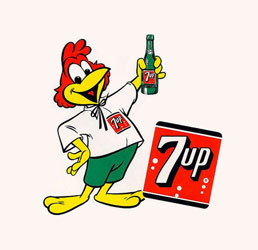 During the 1950’s Fresh-Up Freddie was the 7UP mascot. It was a rooster dressed in human clothes. In commercials he gave viewers advice on how to plan successful parties and picnics by having plenty of 7UP on hand.
During the 1950’s Fresh-Up Freddie was the 7UP mascot. It was a rooster dressed in human clothes. In commercials he gave viewers advice on how to plan successful parties and picnics by having plenty of 7UP on hand.
When I look at the brand today, 7UP is still a party brand. But it has transformed to cater to the tastes and expectations of a youth market. In 2015, teenagers don’t think of picnics as parties. Naturally 7UP has evolved their brand and marketing to engage its target market
The Fresh-Up Freddie mascot fit a moment in time, and was abandoned by the 1960s to cater to a new youth market. 7UP’s brand strategy will continue to transform every decade or so to reach a new youth market.
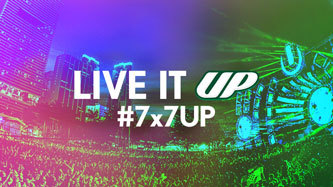 Since 2014, the 7UP brand tagline is “Live it up.” The campaign is focused on targeting fans of electronic dance music. There’s no brand mascot to be seen, and that’s ok. Maybe the next generation will gravitate back towards the ideals of a mascot.
Since 2014, the 7UP brand tagline is “Live it up.” The campaign is focused on targeting fans of electronic dance music. There’s no brand mascot to be seen, and that’s ok. Maybe the next generation will gravitate back towards the ideals of a mascot.
What makes brand mascots iconic is their relevance to their brand. The better a mascot can personify a brand, the more consumers will embrace it. But a mascot becomes a liability when its not effectively linked with the brand strategy. A mascot that doesn’t personify the brand is less relevant and less likable. If the mascot doesn’t fit, abandon it.
Mascots Are Characters, Not Cartoons
Brand Mascots come in all shapes, sizes, and personalities. They’re as different as the brands they represent.
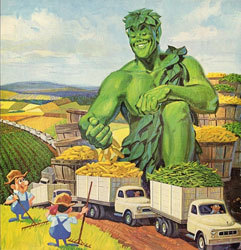 Mr. Peanut has a very different personality than the Jolly Green Giant. Dotz explains, “[The Minnesota Valley Canning Company] wanted to publicize the fact that it had developed an uncommonly flavorful and tender ‘giant’ -size pea … the buff Jolly Green Giant is the personification of the link between vegetables and good health.”
Mr. Peanut has a very different personality than the Jolly Green Giant. Dotz explains, “[The Minnesota Valley Canning Company] wanted to publicize the fact that it had developed an uncommonly flavorful and tender ‘giant’ -size pea … the buff Jolly Green Giant is the personification of the link between vegetables and good health.”
We don’t know the Jolly Green Giant as the life of the party. We know him as big, strong, healthy, and natural. He’s more like Mr. Clean than Mr. Peanut.
Brand mascots also transcend cartoons. You can build brand mascots with human beings. The Maytag Repairman, known as Ol’ Lonely, has been sitting idly by since 1967. He personifies Maytag’s brand promise, “reliably dependent.”
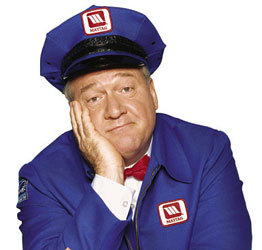 Other brands like Old Spice and Dos Equis are effectively using human mascots in their advertising. Millions of people watch the Old Spice Man, Isaiah Mustafa, and his antics. Dos Equis created “The Most Interesting Man in the World,” portrayed by Jonathan Goldsmith. These characters don’t fall into the classic model of cartoon mascots, but they are no less effective than the Jolly Green Giant or Mr. Peanut.
Other brands like Old Spice and Dos Equis are effectively using human mascots in their advertising. Millions of people watch the Old Spice Man, Isaiah Mustafa, and his antics. Dos Equis created “The Most Interesting Man in the World,” portrayed by Jonathan Goldsmith. These characters don’t fall into the classic model of cartoon mascots, but they are no less effective than the Jolly Green Giant or Mr. Peanut.
Companies that grow iconic brand mascots breathe life into them. The mascot isn’t just a drawing or a spokesperson, it’s a character. This requires developing its personality, its likes and dislikes, how it interacts with others, its story, and what it stands for. Without a personality, a brand mascot is simply a brand symbol.
A Mascot to Know and Love
What’s so remarkable about the two volumes of Meet Mr. Product is seeing the history of brand mascots.
Every marketer should own both copies. These illustrations are our roots, but they also highlight the power brand mascots have to pull on your heartstrings.
The books have rekindled my interest for working with brand mascots. While building the LEAPJob brand, my family’s former business, we developed “Leapy the Frog.” Leapy was born out of a desire to differentiate our brand visually from other recruiting agencies. Most agencies use bland and predictable brand imagery: smiling models, people shaking hands, puzzle pieces, nautical imagery, and other cliches.
 We created Leapy, a red-eyed tree frog that was always in motion, to demonstrate the energy and excitement of advancing your career. Our guidelines for the mascot were he always had to be leaping, he could never be touching the ground, and he had to be smiling and having fun.
We created Leapy, a red-eyed tree frog that was always in motion, to demonstrate the energy and excitement of advancing your career. Our guidelines for the mascot were he always had to be leaping, he could never be touching the ground, and he had to be smiling and having fun.
It was a ton of fun developing the character, and we ran internal discussions and competitions to come up with new scenarios for Leapy to leap. He jumped his briefcase. He was shot out of a cannon. He was catching butterflies above a field. He practiced his pole vault. He even drop kicked a city.
Thumbing through the pages of Meet Mr. Product brought back all the memories of developing and using the LEAPJob mascot. I am working with my design team to create a mascot for Sticky Branding. The theme for the brand is “Attracting Customers Like Bears to Honey.” We’ve decided we need a bear to represent this theme. Hopefully we can groom him into our mascot.
 These projects are the fun parts of branding. This is where you get to really let your creativity fly and find fun and innovative ways to personify your brand. It’s the kind of project that makes you smile, because you’re building brand assets that will connect with your customers at a personal level. So much of marketing is sterile and numbers driven, but working with a brand mascot brings the human side back into marketing.
These projects are the fun parts of branding. This is where you get to really let your creativity fly and find fun and innovative ways to personify your brand. It’s the kind of project that makes you smile, because you’re building brand assets that will connect with your customers at a personal level. So much of marketing is sterile and numbers driven, but working with a brand mascot brings the human side back into marketing.
But more importantly, brand mascots move the sales needle. When you can connect with your customers at a deep, personal level — a human level — they’ll choose your brand first. The mascot is your tool to demonstrate your brand’s values, and a focal point for your customers to know your company, like it, and trust it.
August 6, 2015
Make Your Brand Iconic: The Power of Symbols in Branding
I am starting to get back into the work groove following my eye surgery. My vision isn’t back to normal. It appears my left eye was overcorrected, which means it’s slightly out of focus.
Most things are clear. I can drive, watch TV, and I am getting back to the gym. But I find myself covering my left eye to read. (Should I add “pirate” to my resume?  )
)
As a result, I am finding myself drawn to pictures over words. This slight shift in perspective is making me see just how prolific and important symbols are to brand communications.
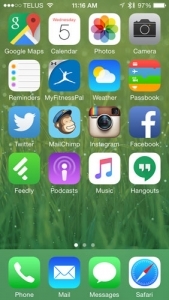 For example, when I look at my iPhone I don’t need to see the words. The icons tell the story.
For example, when I look at my iPhone I don’t need to see the words. The icons tell the story.
On my homescreen I have my most used apps. Each app is represented by a small symbol — an icon. Mailchimp has Freddie the monkey. Twitter is represented by a singing bird. Facebook uses its stylized F, and Instagram has a retro looking camera.
Without any words we know what these symbols represent, what they mean, and where they fit in our lives. They help us navigate the world — especially online.
Symbols are a powerful element of your brand identity system that extend beyond your logo. The goal of brand builders is to create a visual shorthand using symbols to connect and engage your customers.
The Roots of Symbolism
Symbols are as old as humans. They’re even older than the written word.
Symbols primarily originated with established religions: the cross, the Star of David, the laughing Buddha. These symbols are markers. They help people demonstrate their beliefs, find like-minded people, and identify specific people and things. Dan Redding writes, “We perceive, understand, and negotiate the world around us by investing meaning in all manner of signs and symbols.”
Over the past 150 or so years, symbols have become far more prolific. They’ve extended beyond religions and movements, and they’ve been adopted as a primary communication device of brands.
With the rise of the industrial era companies gravitated towards using logos, mascots, and symbols to differentiate their brands. Naomi Klein writes in No Logo, “In the 1880’s, corporate logos were introduced to mass-produced products like Campbell’s Soup, H.J. Heinz pickles and Quaker Oats cereal.”
The logos were designed to evoke familiarity and connection, and to replace shopkeepers and grocers from being the primary interface between products and consumers. The logo was a symbol to signal to consumers a certain level of quality, experience, and trust.
This concept has only grown. From the 1960’s onwards, logos and symbols of brands have shifted from packaging to pop-culture. The brands you use, wear, and display all tell little stories. They help you express your personality and beliefs, and they help others identify with you.
This creates an opportunity for brands. We live in a world of choice, options, and information. There’s no shortage of products to select. To stand out and connect with customers you need to draw on a very old and very well established tool, symbols, to effectively connect with your customers.
A Visual Shorthand
Symbols provide a visual shorthand that makes them valuable communication devices.
As people interact with a symbol — whether brand, religious, or otherwise — it gets packed with meaning. It becomes a heuristic of what’s to come. When you see a person wearing a white jacket and a stethoscope you think they’re a doctor. The white jacket and stethoscope are the symbols of the profession, and when combined we naturally assume the person wearing them must be some kind of doctor.
We look to symbols as a visual shorthand to communicate our thoughts and beliefs. “They are mini-billboards of our thoughts, feelings, emotions and values,” writes Joe DePaola. “They serve a shorthand method of communicating at a glance something which could take several sentences, pages or books to explain in words.”
With my vision being out of sorts I don’t want to look at tiny print. I gravitate towards brands that can clearly convey their value proposition and utility without study.
 McDonald’s has applied this principle effectively for decades with the Golden Arches. The arches are positioned to be clearly visible to passing motorists. It’s a sign to drivers that there is a comfortable place to rest and have a meal.
McDonald’s has applied this principle effectively for decades with the Golden Arches. The arches are positioned to be clearly visible to passing motorists. It’s a sign to drivers that there is a comfortable place to rest and have a meal.
The prominence of the Golden Arches make it a powerful symbol for the McDonald’s brand. The symbol is packed with both personal and cultural meaning, and it quickly conveys a story about each McDonald’s location.
This leads to an interesting branding challenge. How can you create a symbol like the Golden Arches for your brand? The arches stand on their own. They don’t need a tagline or explanation. You know instantly what they are and what they represent. Can you create a similar visual shorthand for your brand?
Symbols Go Beyond Logos
The most common symbol a company develops is its logo. But let’s push beyond the logo.
Logos can function as a symbol, but most logos are not designed to fit that purpose. Logos are crafted to present the company name in an attractive, functional way. Symbols, on the other hand, are mini-billboards. Their job is to connect the tribe and convey meaning.
A great example of modern brands developing symbols is in the app market for mobile devices. A mobile device has limited room to convey information. As a result, app makers have embraced icons to represent their brands:

The icon is the modern day symbol for most brands. It’s small yet functional. Icons have to be clear at 32×32 pixels, which is a box less than half an inch. Try cramming your logo into such a small space and see how good it looks.
Facebook’s logo is its wordmark, but most people identify the product by its F icon. Twitter’s icon plays on its metaphor of a singing bird. These icons are deliberately designed to function as symbols versus logos. They’re containers of what the brand represents, as well as navigation devices of how to use them.
Manage Your Brand Symbols
Any company, and I would argue almost every company, has an opportunity to develop brand symbols. Some symbols will be digital assets like icons, and others may be physical symbols like the Coca-Cola bottle.
The hourglass lines of the Coca-Cola bottle is one of the most famous shapes in the world. And it was deliberately designed that way.
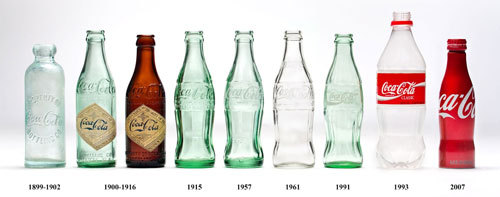
In the early 1900’s Coca-Cola was already a powerful brand with a distinctive logo, but the company was concerned the logo was not enough. At the time the soda was packaged in a standard straight bottle that was either brown or clear.
According to Ted Ryan, the company wanted to protect its business by developing more symbols that would resonate with consumers. In 1914, Harold Hirsch, the lead attorney for the Coca-Cola Company, made an impassioned plea to his company to change its bottle. He said, “We are not building Coca-Cola alone for today. We are building Coca-Cola forever, and it is our hope that Coca-Cola will remain the National drink to the end of time.”
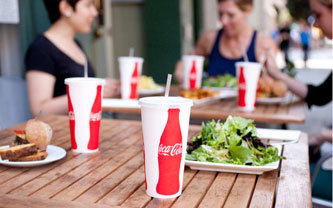 Coca-Cola took deliberate steps to convert its bottle into a symbol. To create a brand that would last through the generations the company developed a design challenge: create a “bottle so distinct that you would recognize if by feel in the dark or lying broken on the ground.”
Coca-Cola took deliberate steps to convert its bottle into a symbol. To create a brand that would last through the generations the company developed a design challenge: create a “bottle so distinct that you would recognize if by feel in the dark or lying broken on the ground.”
The result is the Coca-Cola bottle that we all know and recognize.
Coca-Cola’s desire to express its brand led to the development of a powerful symbol. It’s a shape packed with meaning and history, and one we immediately associate with the Coca-Cola brand.
Pack Meaning Into Your Brand
The Coke bottle story is a classic one, but the lesson is relevant for almost every brand. Coca-Cola recognized it couldn’t defend and grow its brand on a logo alone. They needed tangible symbols that embodied the brand. And you can do this too.
What areas of your brand can you distill and express through a simple visual shorthand?
The key to developing your brand symbols is to focus on function. Coke challenged itself to create a bottle that was recognizable “by feel in the dark or lying broken on the ground.” The company’s focus on function led to an iconic design.
Douglas Atkins states in the Culting of Brands, “There are also dangers in creating a symbolic system that is, well, symbolic of nothing. Aesthetics are not enough. Icons are only icons because they communicate a world of meaning to the community that honors them.”
Developing symbols for your brand are deliberate, and they take many forms. Symbols can be a navigational tool like the Twitter and Facebook icons. Symbols be a differentiator like the Coca-Cola bottle. Symbols can be a status symbol like Apple, Versace’s Medusa, and Ferrari’s prancing horse.

This is where I see a big shift from developing logos and symbols. A logo can simply be a thing you put on your website and business cards. A symbol is something you create to convey meaning.
Social media icons are used to convey connection: “Like us on Facebook” or “Follow us on Twitter.” These platforms use their icons to help people and tribes connect with one another.
To create symbols for your brand start with a key customer touch point. Coca-Cola, for example, focused on its bottle because it was the direct point of contact between the consumer and product. What is the most visible or prominent customer touch point with your products and services? This a good starting point. Challenge your team to develop a visual shorthand that not only conveys meaning, but enhances the customer experience.
The T-Shirt Test
It’s often discussed that the epitome of branding is making your brand “tattoo worthy.” This is when you connect with your customers at such a deep, personal level they are willing to ink your brand on their skin.
I am not holding symbols up to the same standard. Instead make your symbols “t-shirt worthy.”
We live in a very branded society. You’re more likely to see a branded t-shirt than a blank one. Naomi Klein says, “Logos have grown so dominant that they have essentially transformed the clothing on which they appear into empty carriers for the brands they represent.”
I don’t consider this a bad thing. The logos we display on our clothing represent our values, beliefs, and connections. They signal which tribe you belong to.
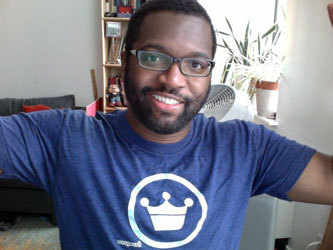 Foursquare, the local search and discovery app, uses t-shirts to promote the brand. Users like Baratunde Thurston proudly wear “mayor” t-shirts. To an outsider this might not mean much, but to people who use the app it’s a symbol.
Foursquare, the local search and discovery app, uses t-shirts to promote the brand. Users like Baratunde Thurston proudly wear “mayor” t-shirts. To an outsider this might not mean much, but to people who use the app it’s a symbol.
In Foursquare you become mayor of a location, like a restaurant or coffee shop, by checking in more than anyone else. When you achieve the mayor status Foursquare rewards you with a crown badge. And depending on the location, these crown badges can be highly coveted.
The mayor t-shirts extends the digital realm of the Foursquare app to the real world. This helps the brand grow awareness, engage its users, and build loyalty.
Creating a symbol that works on a t-shirt is easier said than done. Most logos look terrible on a t-shirt. Walk around any trade show and ask yourself, “Would I wear these logo’d golf shirts in public?”
For a symbol to work on a t-shirt it has to adhere to three qualities:
Simple: Simple images do better than complex ones. The Foursquare mayor symbol is identifiable as an icon or a large graphic on a t-shirt. The simplicity of the image allows it to be widely recognizable.
Connective: A symbol is more than a graphic. It has to be packed with meaning. Foursquare uses the mayor crown as a symbol, because that’s a badge people strive to acquire in the app. Use images that are packed with meaning and resonate with your tribe.
Attractive: This may be obvious, but it can’t be overstated. Iconic symbols like the Apple logo or the Coca-Cola bottle have a powerful aesthetic quality. They are well balanced, well designed, and something people are proud to wear. Iconic symbols are beautiful.
If you can create a symbol that works on a t-shirt, that’s a pretty good sign it will work almost everywhere. And if you do create a symbol that is t-shirt worthy, then by all means print a bunch of t-shirts to give away. Get your customers to wear your brand.
Symbols Build Brand Equity
Every iconic brand has symbols, because it enhances the economic value of the respective corporation.
David Aaker writes in Managing Brand Equity, “The reality is that most firms and products are fairly similar; the differences that do exist, such as service quality, are difficult to communicate in an effective and credible manner. When products and services are difficult to differentiate, a symbol can be the central element of brand equity, the key to differentiating characteristics of the brand. The symbol can by itself create awareness, associations, and a liking or feelings which in turn can affect loyalty and perceived quality.”
The symbol isn’t an artistic expression of the brand. It’s an emotive communication device that’s been used since the dawn of mankind. And it’s one of your most effective devices to stand out in a highly competitive, information rich marketplace.
A great product with a strong value proposition may not be enough. Consumers don’t truly believe there is a huge difference between products. That’s why we need to connect with them at a deeper level.
I’ll ask it again. How are you going to visually convey your value proposition and beliefs in a short, concise way?

